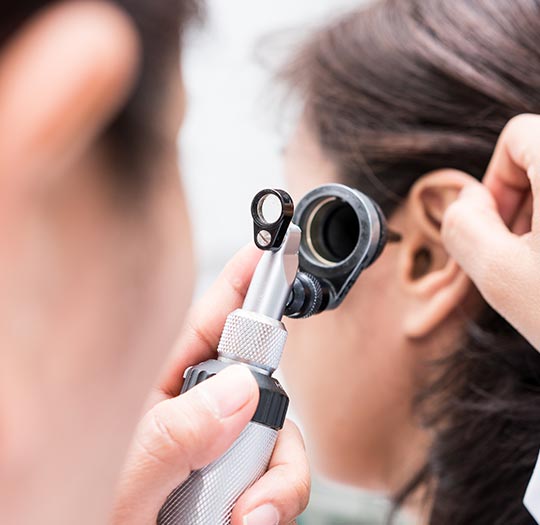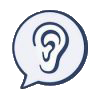
Otoacoustic emissions or OAE testing is a method of measuring how well your inner ear is working.
Your ear has three parts, your outer ear, your middle ear, and your inner ear, also known as your cochlea.
Your inner ear gives off sounds of its own when it responds to a sound coming into your ear from outside your body.
These sounds are known as otoacoustic emissions, or OAEs. They are very quiet sounds that echo back into your middle ear. OAE testing measures the intensity or absence of these sounds.
People who have normal hearing produce OAEs. If your hearing loss is greater than about 25 decibels, your inner ear will not produce these sounds.
OAE testing can show there is a blockage in your outer ear or in your middle ear. If there is a blockage in your outer ear or in your middle ear, sounds will not reach your inner ear.
If sounds do not reach your inner ear, they will not be reflected back to your middle ear.
How Your Audiologist Performs OAE Testing?
You don’t have to do anything to have OAE testing. Your audiologist places a small probe in your ear. The probe sends sound into your ear and measures what comes back.
Your audiologist sees the results on a monitor.
Because OAE testing doesn’t require any kind of participation from the person being tested, it can be done on newborns, unconscious people, sleeping people, people in comas, and people who deal with developmental challenges.
It can also reveal hysterical or feigned hearing loss.
What Does OAE Testing Measure?
Audiologists use OAE testing to determine whether newborns have normal hearing. They can use OAE testing to measure the sensitivity of your hearing, how faint a sound you can hear.
They can also use OAE testing to determine how much hearing loss is due to mechanical problems in the ear and how much has a neurological component.
OAE testing has been around for about 40 years. In the early days of audiology, hearing specialists theorized that the hairs inside the cochlea (the inner ear) that vibrate with sound might make sounds of their own.
It wasn’t until the late 1970s that scientists actually measured these sounds when engineers had solved the problem of how to detect these faint sounds made by the ear itself even with noise from other sources outside the ear.
Four Different Kinds of OAEs
Audiologists use OAE testing to measure four kinds of OAEs:
- Sounds emitted by the inner ear without an external stimulus. These sounds are known as spontaneous OAEs.
- Sounds emitted by the inner ear in response to bursts of sound or clicks. These sounds are known as transient OAEs.
- Sounds emitted by the inner ear in response to two simultaneous tones of different frequencies. These sounds are known as distortion OAEs.
- Sounds emitted by the inner ear in response to a continuous tone. These sounds are known as sustained-frequency OAEs.
Pure-tone audiometry, your response to a tone you hear (or don’t hear) through headphones measures your hearing as a whole. It measures how well your outer ear, middle ear, inner ear (cochlea), cranial nerve VII, and auditory brainstem work together to give you the perception of sound.
OAE testing narrows down problems to just the peripheral auditory system, your outer ear, middle ear, and cochlea (inner ear). By itself, it can’t pin down the cause of noncochlear hearing loss.

What Does Your Audiologist Need to Get Useful Results from OAE Testing?
OAE testing doesn’t require a lot from the patient other than the ability to sit still without talking, humming, singing, or any other form of vocalizing. OAE testing doesn’t require a sound booth, but it can’t be done in a noisy room.
Additionally, your audiologist may not be able to perform OAE testing if:
- There is an obstruction in your outer ear canal.
- Your audiologist cannot seat the probe inside your ear. This can be a problem when there is infection or inflammation of the ear canal or the Eustachian tubes.
- There is some condition interfering with the equalization of pressure on both sides of your eardrums.
- You don’t have functioning hair cells in your inner ear. Hair cells can be damaged by frequent exposure to loud noises or traumatic exposure to extremely loud noise. They can also be damaged by disease.
How Your Audiologist Interprets the Results of OAE Testing?
Only about 40 to 50 percent of people who have normal hearing will have spontaneous OAEs. If you have spontaneous OAEs, this is a sign that you have good hearing. But if you don’t have spontaneous OAEs, this doesn’t mean that you have a hearing problem.
Spontaneous OAEs usually generate a sound with a frequency of 1000 to 1500 Hz (cycles per second). That’s about the same pitch as a short letter o, as in hot. But because a spontaneous OAE happens so quickly and so often, you don’t notice it.
Spontaneous OAEs usually occur in one ear, not in both ears. They are more common in women than in men. Occasionally spontaneous OAEs are so loud that other people can hear them.
Transient OAEs help your audiologist gauge the sensitivity of your hearing at different frequencies. Distortion OAEs can help your audiologist detect the early stages of deterioration of hair cells in your inner ear, for instance, after exposure to certain antibiotics.
OAE testing won’t find neurological problems that affect your hearing, but it can be very useful in pinpointing other causes of hearing loss and how hearing aids can compensate for it.
The hearing specialists at Harbor Audiology can provide you with the hearing care you need to achieve the best hearing possible. We can help you choose the best of the most advanced hearing aids.
Schedule an Appointment with Harbor Audiology Today
Harbor Audiology is experienced in filing for VA benefits, and we work with all major insurance plans. We are open most evenings and Saturdays. Harbor Audiology has offices in Tacoma, Gig Harbor, Silverdale, Sequim, Port Angeles, and Federal Way. Request your appointment online today!






